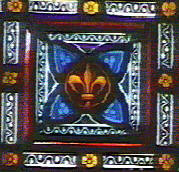 Stained Glass by
Pugin—SITE STILL UNDER MAINTENANCE as at 2nd December, 2005
- Pugin was one of England's great architect-restorers, and he designed
Medieval-looking stained glass too. This page contains samples of his
work for St Augustine's, Ramsgate, UK, of 1844. It is very slow loading,
but the images are rather good. Of course, now that you know what
Medieval glass looks like, this stuff probably wouldn't fool you - the
designs are inspired as much as anything by Medieval floor
tiles, which he also knew and designed.
Probably worth waiting for the above site to come back. Meanwhile, here are some of Pugin's windows in Buckinghamshire —NEW LINK 2nd December, 2005
Stained Glass by
Pugin—SITE STILL UNDER MAINTENANCE as at 2nd December, 2005
- Pugin was one of England's great architect-restorers, and he designed
Medieval-looking stained glass too. This page contains samples of his
work for St Augustine's, Ramsgate, UK, of 1844. It is very slow loading,
but the images are rather good. Of course, now that you know what
Medieval glass looks like, this stuff probably wouldn't fool you - the
designs are inspired as much as anything by Medieval floor
tiles, which he also knew and designed.
Probably worth waiting for the above site to come back. Meanwhile, here are some of Pugin's windows in Buckinghamshire —NEW LINK 2nd December, 2005 |


![]()

![]()